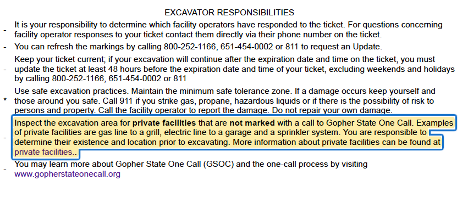
Once you’ve called 811 or filed a locate request ticket online for your excavation, it might seem like there’s nothing left to do but wait for a positive response from facility operators. But many first-time homeowner excavators don’t know that filing a locate request with Gopher State One Call is just the first part of the underground utility locating process. There is another very important step to take before you dig: contacting a private utility locator.
If you’ve filed a locate request with Gopher State One Call via phone, you may have noticed a recording at the end of your call reminding you to have private facilities located before you dig. And if you file a ticket online, there will be a reminder in your ticket confirmation email, like the one below.
But what are private utilities and how does locating them work?

When Gopher State One Call contacts utility operators to locate a property, those operators only locate public facilities for which the company is responsible, and that are part of the community infrastructure (for example, sewer lines, gas pipelines or fiber optic lines that serve you and your neighbors). Private utilities that specifically serve your property and home, however, are the responsibility of the property owner.
Schools, multi-unit housing, office parks and other businesses and organizations typically also have private utilities on their grounds, but in this article, we’ll be addressing the homeowner’s role in protecting private utilities.
Private Utilities vs. Public Utilities
If you’re still unclear on what constitutes a public utility versus a private utility, you’re not alone. Christopher Koch is president of Minnesota-based ZoneOne Locating, which locates private utilities and provides contract public locating services for facility operators. Koch says he and his staff regularly clarify this distinction with private locating clients. “I think what causes some frustration for homeowners is that it’s not always easy to tell,” he says.
“I always see the meter as a demarcation point,” explains Koch, who has worked in the damage prevention industry for 25 years, beginning as a route locator in the mid- ‘90s. “For your telephone system, you’ll have a subscriber network interface on the side of the home that’s a little gray box. Same thing with the cable TV. Electric and gas systems, you’ll have a meter. Often, anything after that meter is going to be customer owned.” (Note that water and sewer laterals may be private utilities—homeowners should contact their local municipality to find out what portion of water and sewer lateral lines are the homeowner’s responsibility to locate.)
When in doubt, Koch suggests following the logic of, “If the line were broken, who would you call for repair?”
“Sometimes asking that question helps jog people to the right conclusion,” he says. If the lights in your swimming pool or gazebo go out, for example, you would call an electrician yourself. “But if the transformer in your front yard blew up, you'd call Xcel Energy.”
Examples of Private Utilities
Private underground facilities that homeowners may encounter include, but are not limited to:
- Electrical, gas or water lines to outbuildings
- Pool heating systems
- Sprinkler systems
- Invisible fencing
- Wells and septic systems
- Satellite dish lines
- Gas lines to fire pits or grills
“The most common utility that we find is power to a detached garage, especially in Minneapolis and St. Paul,” Koch explains. “We [locate] tons and tons of buried lines to garages—and that’s typically [in preparation for] home landscaping projects or fencing.” He adds that while often it’s a simple power line to the garage for lights and a garage door opener, some garages may have a gas line to run a heater or other equipment. “Sometimes we get one [where] somebody operated a business in the past, so they’ll also have a telephone landline.”
Private utilities can vary depending on the location and age of your property and community. In suburban areas and newer neighborhoods, ZoneOne often encounters control wiring for sprinkler systems. Waterfront homes and cabins may have extensive drainage systems, gas lines for fire pits or electrical outlets running to a dock for a boat lift.
In rural areas, Koch says ZoneOne often marks liquid propane lines, wells, septic systems and power to outbuildings. Sometimes,“electrical cooperatives will put the meter on a pole, and the service to the actual customer’s residence will be private,” he explains. “That happens with farmsteads as well.”
Preventing Private Utility Damages: A Life-or-Death Issue
The stakes may seem lower when you’re talking about pool heaters and landscape lighting versus major gas pipelines and transformers, but a damage is a damage. “You don't have to hit a 13-kilovolt electric line to kill yourself and kill somebody else,” Koch notes.
A private utility damage “can be equally calamitous” as a public utility damage, he explains, giving the example of Jason Joseph Menteer, a city crew worker in Oregon who died in 1999 at age 22. Menteer had been completing an emergency water system repair in the middle of the night when he was electrocuted by an energized streetlight line that hadn’t been located.
“This was a simple streetlight line that killed this young man. Any electric line buried in your backyard is dangerous and has the potential to harm or kill. When you talk about gas lines to swimming pools and grills, that's still natural gas. It can still migrate, it can still collect, it can still cause a potential explosion,” Koch says. “Utilities have potential to cause a hazard and real harm.”
Beyond injury or death, some private utilities can cause expensive or even catastrophic property damage. “A water line to a residence could flood the basement and [result in] tens of thousands of dollars of damage,” says Koch. “Even when a severed utility line doesn't cause any property damage or personal injury, you still have to bear the cost of repairing it.”
Learn more about private facilities and see a diagram in the Gopher State One Call homeowners guide (click “Homeowners Guide” in the yellow box).
Homeowner Tips for Having Private Utilities Located
Whenever a property owner files a locate request with Gopher State One Call, they’ll either be read or emailed (depending on how they submitted their ticket) a reminder to have private utilities located. Below are a few tips to make sure the process goes smoothly.
- Be prepared, but flexible. You may want to check cost and availability of local private utility locators before you submit your Gopher State One Call ticket, but Koch recommends waiting to have private facilities located until afterpublic utility locators have marked the area. While locator availability will vary, especially during the warmer months when more excavations occur, he says that ZoneOne works on a similar timetable to public locators—so expect at least a two-day turnaround. (Koch adds, however, that more scheduling lead time is always preferable.) It’s important to have public utilities located first in case there are any jurisdictional disputes or gray areas, as marking practices can vary from city to city, he adds. It’s also a good idea to factor in the additional time and cost for private utility locating while planning excavation equipment rentals and labor.
- Know that there are no guarantees. While locators do a thorough job of marking private utilities, they are automatically at a disadvantage since they don’t have the benefit of underground facility maps like a public utility locator would have. “When we go out to private lines, we’re flying by the seat of our pants. We’re looking for top side signs of the presence of underground utilities and then trying to figure them out as we go,” says Koch.
Another factor is that not all private underground lines are metallic, and most locating is done by a process called electromagnetic induction. “The one downfall of electromagnetic induction is that it cannot be used to find non-metallic facilities,” Koch explains. However, some non-metallic lines are buried with a tracer wire or other mechanism to locate them through electromagnetic induction. “Some septic systems are buried with an alarm or even a power line on a post by the septic tank. We can find those because we're actually finding the metallic lines that accompany them,” he says. “But the plastic pipe itself that runs to the septic tank—we can't find it if it's not accompanied by a metallic structure of some kind. So we sometimes have to disappoint people.” If you’re planning to have private utilities installed—for example, a gas line for a pool heater—Koch suggests asking the company to bury a tracer line for future locating. - Leave the public utilities to public locators. It might seem like any locator should be able to locate any underground utilities. After all, they’re already on site with the equipment. But locators working on behalf of a public utility company cannot locate a property owner’s private utilities, and vice versa. If a locator working on behalf of a private property owner marks public lines outside the bounds of the state one call process, “We’re really helping [the homeowner] violate state statute,” Koch explains. “On top of that, we're inserting ourselves into a contractual relationship that [the facility owner] has with another vendor—a company perhaps like us. So we're really jumping two fences.”
- If you’ve forgotten to call a private utility locator, course correct before you begin digging. For those who didn’t initially incorporate a private locate into their excavation plans, it’s imperative NOT to skip this step even if you’re behind schedule or have contractors waiting. While it’s always better to plan ahead, Koch says his company gets some property owners calling in a panic once they realize that they never built in the private utility locating process into their work schedule. “Suddenly they see this potential safety hazard, these unmarked lines in their backyard. They call [and ask], ‘Can you send somebody out right away?’ Oftentimes we can accommodate them. And when we can't, we feel terrible. We really do kind of bend over backwards to get to them when they're in that emergency situation, though.”
- Budget for the cost of private locating up front. Koch notes that some property owners are discouraged to learn that the private utility locating cost is their responsibility, since it’s widely known that filing a public utility locate request through Gopher State One Call is free. Homeowners should know going in that there will be a cost for this service. “We're used to dealing with [surprised homeowners] and they understand in the end, but they’re sometimes initially frustrated and suspicious,” he says. But, “I view the very reasonable fee that we charge for a private locate as money well spent. It’s an investment toward mitigating your risk of causing damage.”
Learn more about private facilities in the Gopher State One Call homeowners guide. Visit GSOC’s private facility locator list to find a private utility locating company near you.
